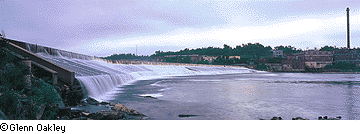
Roller-compacted concrete, which emerged as a viable means of constructing
dams in the 1980s, allows much faster and less expensive construction than
traditional methods. Roller-compacted concrete has several advantages and
disadvantages when compared to traditional dam construction. However the
advantages often outweigh the disadvantages, and RCC dams are quickly gaining
world-wide acceptance. All six inhabited continents have at least one roller-compacted
concrete dam, and many more are under construction throughout the world.

Roller-compacted concrete is simply concrete constructed with the use of earthfill methods. Several special considerations must be taken into account when designing a roller-compacted concrete structure. The first RCC dams displayed excessive seepage problems, however several seepage control systems have been devised to decrease these flows to traditional dam flow levels. In fact almost all dams leak one way or the other, either through the foundation or through the dam itself. The majority of seepage problems can be attributed to the lift joints.
The use of bedding mortar over
the entire area of the lift joint, waterstops, precast facing panels and
internal draining systems have effectively limited the problems associated
with seepage to an acceptable level. The use of bedding mortar ensures
bond strength between joints by filling the voids that occur between lifts.

RCC dams often employ standard twelve-inch polyvinylchloride or polyethylene waterstops, which run perpendicular to the lift joint and to block the passage of water.
Precast conventional concrete facings can be placed on RCC dams to provide an increased water tightness at the upstream face. These facings also serve to protect the dam against climactic variances, since no means of introducing air-entrainment into roller-compacted concrete has yet been discovered. Air entrainment, tiny air bubbles in cement, allows freezing water a place to expand into, and consequently reduces any damage associated with freezing and thawing conditions. This is because of the lack of plastic paste in the mass of the roller-compacted concrete which is where the air entrained bubbles exist.
Even with these precautions water will still enter the dam because of shrinkage cracks. Modern dams are mostly constructed without reinforcing steel , and thus shrinkage cracks are formed through which water is able to flow. These cracks allow water seepage. Given the large size of dams, placing reinforcing steel would dramatically raise the cost of the project. This water flowing through the shrinkage cracks is controlled through the use of an internal drainage system. This drainage system basically consists of a series of passageways that conduct the water to flow to a desired location once it enters the dam. Because of the mass of concrete present, these devices do not significantly reduce the strength of the dam. The primary collection device is the drainage curtain. This consists of a series of approximately three-inch vertical holes in the roller-compacted concrete to direct the water to a drainage gallery running the length of the dam. In roller-compacted concrete dams the drainage gallery often increases construction time and increases costs because the earthfill method being used does not easily accommodate such a construction. One possible method to decrease gallery construction time is to use precast concrete gallery segments, however this method has not yet been attempted. Fortunately, most dams under 100 feet (30.5m) high do not have enough internal water flow to necessitate the use of a gallery, so in reality galleries prove to be a minor problem associated with roller-compacted concrete dams.
Because of their construction methods, roller-compacted concrete dams offer a faster and less expensive means of dam construction. Several methods have been used to minimize the problems associated with roller-compacted concrete, which allows competition with traditional dams. Because of their less expensive costs and competitive performance, RCC dams clearly represent the future of dam building.
McGraw-Hill, Inc., New York, 1991.
"Roller-Compacted Concrete," ASCE, New York, 1994.
Hansen, Kenneth D., Guice, Leslie K., "Roller-Compacted Concrete II," ASCE, New
York, 1998.